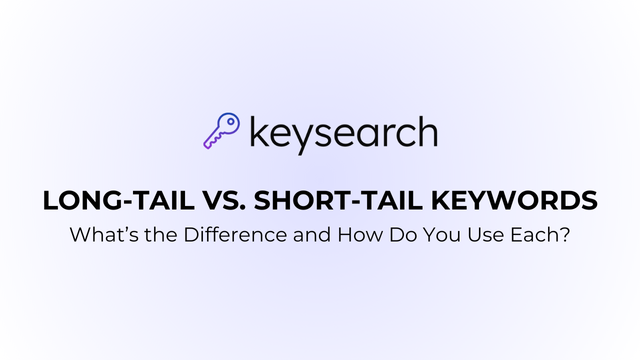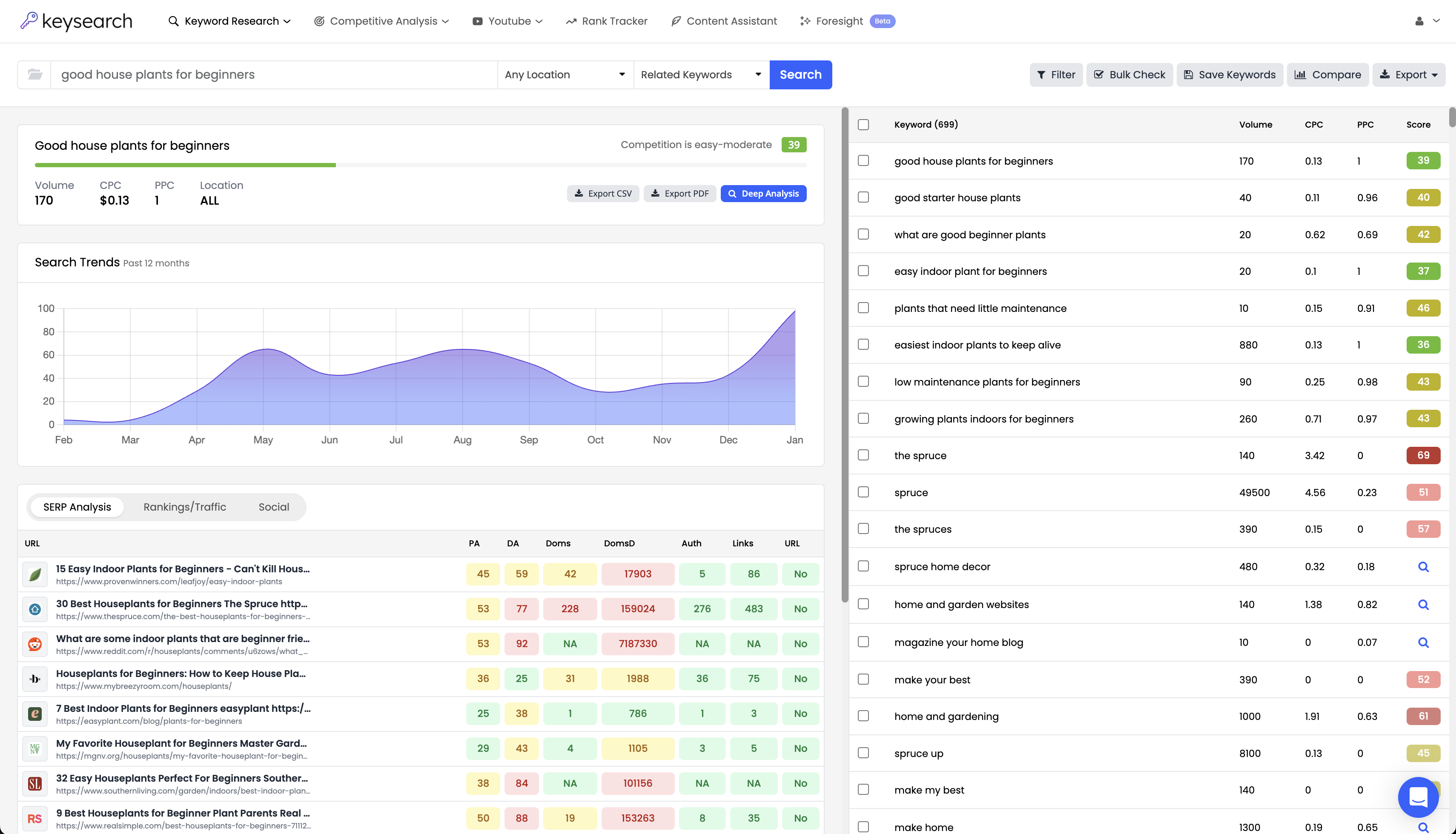We probably don’t have to remind you that not all keywords are created equal. There are so many different metrics to consider, from search volume and difficulty to relevancy, user intent, and more.
But let’s zoom out and look at the two main categories of keywords: long-tail vs short-tail keywords. Each has its place, and the truth is, you’ll need both as part of your strategy. But what are the key differences to consider?
Long-tail keywords are longer, more specific phrases that target niche audiences with lower search volumes but higher conversion potential, while short-tail keywords are broader, more competitive terms that drive higher traffic but often with less targeted user intent.
The key difference is their focus: short-tail keywords are ideal for reaching wide audiences, whereas long-tail keywords help capture more precise, intent-driven searches.
You can learn more about the differences between short-tail vs long-tail keywords below, or, you can get started uncovering the top keywords for your niche with our free SEO tools today. Keysearch helps you find the short-tail and long-tail keywords on autopilot!
What are Long Tail and Short Tail Keywords?
In general, keywords serve as the foundation of any successful SEO or paid advertising strategy. This is why understanding the nuances between short-tail vs long-tail keywords is so important.
So, let’s offer a bit more context before we compare and contrast long-tail vs short-tail keywords side by side. What are long-tail and short-tail keywords?
What are Long Tail Keywords?
So, what is a long-tail keyword? As the name suggests, they’re longer – typically consisting of three or more words. They target niche segments and are often used by individuals with clear intent.
For example, instead of a broad search like “running shoes,” a long-tail keyword might be “best running shoes for flat feet women.”
The benefits of long tail keywords lies in their precision. They typically have lower search volumes but also less competition, making them easier to rank for.
It’s easy to brush these keywords off because of their lower search volumes, but this is a classic mistake. They actually drive better results in many cases because they attract more focused searches.
In this sense, long-tail variations tend to result in higher conversion rates, as users who search for these terms are further along in the buying process or have a specific need.
What are Short Tail Keywords?
On the other hand, short-tail keywords are exactly what you suspect – shorter phrases with a more broad context, typically just 1-2 words. They’re also referred to as seed keywords or head keywords in some cases.
Thinking back to our running shoes example, “running shoes” would be a good short tail keyword. Or even more broadly, “shoes.”
These keywords tend to have high search volumes, making them incredibly competitive. It’s far too easy to fall into the trap of targeting these keywords because the search volume is appealing.
However, it rarely makes sense to try and rank for these keywords unless you’re a massive brand. It’s not just because they’re harder to rank for, either – the intent is different.
Users searching with short-tail keywords might not be as far along in the buying journey, so conversion rates can be lower compared to long-tail keywords.
Similarly, you’ll attract less qualified traffic from a relevancy standpoint. People might search “shoes” if they’re looking for running shoes, but they might be looking for weightlifting shoes, high-heels, casual shoes, or anything else for that matter.
Still, ranking for a single short-tail keyword could potentially be a lifechanging outcome. It can turn the tap on insane inbound traffic and position your site as an authority.
Long-Tail vs Short-Tail Keywords: Key Differences to Consider When Conducting Research
You should have a solid understanding of where the differences lie between short-tail and long-tail keywords already. But to leave you with a crystal clear view of where long-tail vs short-tail keywords should be used, let’s compare them side by side.
Search Volume
Short-tail keywords usually have a much higher search volume. For example, a search term like “laptops” may receive hundreds of thousands of searches each month.
In contrast, a long-tail keyword like “best budget laptops for college students” might not even generate a hundred searches. But if you’re selling affordable laptops specifically to college students, ranking for this lower trafficked term is still going to offer better results.
The key takeaway from this conversation should be that higher search volume doesn’t guarantee more traffic to your website. In fact, targeting exclusively short-tail keywords could cause you to spin your tires and never generate any traffic, especially as a new website.
This is because the specificity of long-tail keywords allows you to target users with clearer intent, which brings us to our next point in this comparison of short-tail vs long-tail keywords…
Competition Levels
We mentioned earlier that short-tail keywords typically come with high competition. Since they are more general and have a larger search volume, many websites, businesses, and advertisers are vying to rank for these terms.
As a result, ranking for short-tail keywords is much more challenging and requires significant SEO effort or a large ad budget.
That doesn’t mean it’s impossible or not worth trying to rank for these terms – just that you should focus on low-hanging fruit along the way, which is where long-tail variations come into play.
These have far less competition so smaller businesses or new websites can rank for these terms faster. You can capture niche markets that larger competitors may overlook, carving out your own space within SERPs.
Learn more about what is a good keyword difficulty score to aim for as you start doing keyword research, or how to find niche keywords.
Cost-Per-Click (CPC) for Paid Ads
It’s not just those conducting an SEO strategy that need to worry about long-tail vs short-tail keywords, but also those running paid advertising campaigns.
Cost-per-click, or CPC, is one of the most important metrics you’ll use, and you’ll see distinct differences in comparing short-tail vs long-tail keywords through this lens.
Short-tail keywords have a much higher CPC due to their competitiveness. If you’re bidding on a keyword like “laptops,” you’ll pay much more per click than if you were bidding on a long-tail variation like “best budget laptops for college students.”
On the other hand, long-tail keywords tend to be more affordable for paid campaigns. Lower CPCs mean you can maximize your ad spend and still reach a highly targeted audience.
This is why we suggest those with a tighter budget focus on these long-tail variations, getting better bang for your buck and avoiding overspending on costly terms.
Conversion Rates
Like we touched on earlier, conversion rates are often higher with long-tail keywords because these searches tend to be more specific and focused. Conversions are ultimately the goal of any SEO or paid advertising campaign, which is why this is such an important realization.
When someone searches for “laptops,” they could be in any stage of the buying process – researching options, looking for reviews, or simply browsing. But when they search for “best laptops under $500 for gaming,” they are likely much closer to making a purchase decision.
Because long-tail keywords attract users with clearer intent, the traffic they generate is often more qualified, leading to better conversion rates. In other words, you’ll see higher cost efficiency with your resources by focusing on these types of keywords.
Relevance to Content Strategy
In terms of content creation, long-tail keywords are easier to incorporate into your strategy because they allow you to be specific and address niche topics in depth. Long-tail keywords work well in blog posts, product pages, and tutorials that target a specific audience or question.
Short-tail keywords can still be a part of your content strategy, but it’s harder to create good content around them because they’re so broad. Still, you might use these for landing page or homepage that introduces general concepts but lacks specificity.
User Intent
This goes back to conversion rate optimization, but the intent behind short-tail and long-tail keywords is far different.
Remember, those searching with short-tail phrases are in the early stages of their search, possibly just gathering information or comparing options. This is known as “top of the funnel.”
Conversely, long-tail keywords are used by individuals who are ready to take action. They’re further down the funnel, somewhere in the middle or even at the bottom, and have already done the research associated with short-tail keywords.
For example, someone searching for “best running shoes for flat feet” is likely looking to make a purchase soon, while someone searching for just “running shoes” may still be trying to figure out whether they even need running shoes, what the different types are, etc.
A Well-Structured Keyword Strategy Features Both Short Tail and Long Tail Keywords!
Ultimately, our goal is not to show you that one is necessarily better than the other in comparing short-tail vs long-tail keywords. Rather, we want you to understand where each has its place so you can create a comprehensive keyword strategy.
Short-tail keywords can help you cast a wide net, while long-tail keywords enable you to target niche audiences and improve conversions. Combining the two is a more balanced approach that attracts visitors at all stages of the buyer's journey.
Whether you want to learn how to do keyword research for YouTube, how to do Pinterest keyword research, how to do Etsy keyword research, or how to do Amazon keyword research, you’ll use both short and long-tail keywords.
That’s why you need a tool that helps you effortlessly uncover the best of both worlds, like Keysearch!
Keysearch Helps You Uncover the Best Short Tail and Long Tail Keywords on Autopilot!
Keysearch takes the guesswork out of your keyword research checklist, empowering you to find the best opportunities on autopilot. Whether you’re looking for seed keywords or LSI vs long-tail keywords, we have tools to facilitate the process and set you up for success.
The best part? Most of our tools are free to start with, so you can hit the ground running today no matter your budget! Simply enter a seed phrase into our long tail keyword generator and see what we come up with for you.
You can quickly analyze a list of opportunities based on keyword difficulty, search volume, competition, and more. You can even search for keyword opportunities on specific platforms you’re trying to rank on – including:
- Amazon keyword generator
- Pinterest keyword tool
- Etsy keyword tool
- eBay keyword tool
- YouTube keyword generator
Whether you're targeting broad, high-traffic terms or niche-specific phrases, our tool helps you find the perfect balance to optimize your content for maximum reach and conversions. You can even analyze your competitors and steal their strategy or identify opportunities they’re missing.
You don’t need to be an SEO expert to execute a winning strategy with Keysearch. Learning how to automate keyword research and what to do after keyword research is simple and intuitive with our solutions, which is why we’ve earned the trust of more than 10,000 users.
So, what are you waiting for? Start uncovering short-tail and long-tail keywords with ease through Keysearch today. Learn about the other tools we have in store for you as well:
- Keyword difficulty tool
- LSI keyword generator
- Duplicate content checker
- Niche finder
- Keyword grouping tool
- Free robot txt generator
- Keyword density checker
- SERP simulator
Bringing our Short-Tail vs Long-Tail Keywords Comparison to a Close
That concludes our detailed comparison of long-tail vs short-tail keywords. As you can see, each has its place, but they’re very different in their traffic potential, competition, conversion capacity, and more.
Short-tail keywords can bring in broad audiences, while long-tail keywords capture more targeted traffic and higher conversion rates. A successful strategy involves leveraging both.
Our blog has additional resources like how to use keywords on Etsy, how to find a profitable niche, does keyword density matter, how to check keyword density, and more. You can also learn more about Keysearch and how it compares to the alternative tools:
But since it’s free to start, why not try Keysearch today and see firsthand what makes it the #1 choice for discovering the best short-tail and long-tail keywords for you niche? Start driving more traffic and conversions to your site today!
- How to Do Keyword Research for Free: Best Free Keyword Research Tools in 2024 - December 13, 2024
- Benefits of Keyword Clustering: Why is it Important to Group Relevant Keywords Together? - December 13, 2024
- What is Keyword Density in SEO and Its Importance - December 13, 2024







